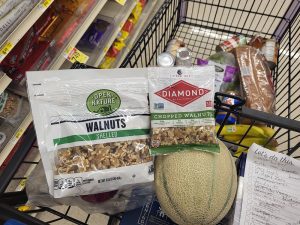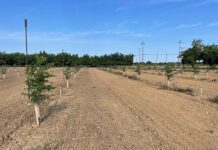Walnut growers, take heart. A new strategic plan to drive profitability and broadly expand demand is about to spring into action to strengthen California’s struggling walnut industry.
Spearheaded by the California Walnut Board and its sister organization, the California Walnut Commission, the plan calls for bold steps to go where walnuts haven’t gone before.
The new road map not only proposes taking walnuts way beyond the baking aisle; it sets its sights on making consumers around the globe crave California walnuts. It outlines six priorities for improving quality, developing innovative products and packaging, and activating sales to increase global customers and consumption avenues.
At its core, however, the plan identifies “grower prosperity” as its mission, said Robert Verloop, president and executive director of both the Board and the Commission.
That’s critical since current conditions are not sustainable for walnut producers. For 2022, most growers were paid only half of their cost of production, said Gordon Heinrich, a fifth-generation walnut producer from Modesto, Calif. He is also part of the 17-member Strategic Planning Task Force that shepherded the strategic plan through its seven months of development.

“One reason this strategic plan is so important is its mission to turn the ship around to sustain growers,” Heinrich said. “If growers are not prosperous, the whole industry will die. If growers prosper, the whole industry wins.”
The new industry strategies, or pathways, were developed with industrywide input from January to July of this year. Participation came from all segments, including growers, hullers, processors and handlers as well as the Board and Commission. The public relations firm of Nuffer, Smith, Tucker served as the process’s strategic planning partner.
The strategic planning process included in-depth interviews with 35 walnut growers, handlers and walnut stakeholders. Three grower roundtables were also held to gather input. An electronic, anonymous survey, open to all in California’s walnut industry, drew more than 650 responses. Global marketing agencies also provided their insights. Drafts of the plan were previewed at public meetings.
Something to Rally Around
With the plan, “the industry is taking an active role to create a thriving and prosperous industry,” said taskforce member Kiran Black, sales director for Sacramento Valley Walnut Growers, LLC, a grower-owned walnut processor. “The plan is exciting and gives us something to rally around.”
Black is especially encouraged by the plan’s pursuit of multiple and largely untapped opportunities for walnuts in the supermarket, food service and food manufacturing segments.

“This is a real opportunity to take walnuts from being an ag commodity to adding value and evolving to the next stage of marketing: becoming part of the food culture,” she said. “The more we amplify and spread the message of walnuts and their great health benefits, the more we help walnuts go from just being a snack food into other eating opportunities.”
A Closer Look at the Game Plan
The 12-page plan, “Driving Grower Prosperity for California Walnuts,” substantiates its six priorities with specific targets for the next five years. Here’s an overview:
Delivering the best quality California walnuts. One objective is to revise grades and standards to ensure the highest quality product, Verloop said. The Board and Commission as well as industry stakeholders will engage in efforts throughout the supply chain to implement best practices and tackle challenges such as rancidity.
Activating sales of California walnuts through global marketing. The Board and Commission will serve as the champion for California walnuts in retail, food service and food manufacturing and ingredient channels. That will include leveraging health research to build consumer awareness and spur sales.
“A key component at the onset is extensive consumer and marketplace research that will provide sound data and insights to drive continuous learning,” Verloop said. “From the research, corrective measures will be made as plans are implemented.”

Fostering innovation to de-commoditize California walnuts. As part of the plan’s unprecedented focus on innovation and fresh ideas, the industry will engage partners to help commercialize new products. “Innovation will no longer sit solely on the shoulders of handlers but rather be driven by the Board and Commission,” Verloop said.
Defining the sustainability story as a point of differentiation for California walnuts. This priority won’t only define what sustainability means to California’s industry. “We will be looking at sustainability requirements from customers and regulators across the globe and seeing how the California walnut industry stacks up in order to develop a sustainability scorecard,” noted Verloop.
Supporting goal-oriented research to improve production and postharvest practices. Verloop said he and his staff will be talking with growers and handlers “to better uncover pain points.” Moreover, 100% of funded research will go toward industry-identified needs. The Commission and Board also will seek opportunities to leverage outside research dollars.

Revitalizing the Board and Commission and aligning on advocacy efforts. “We are upping the ante on grower communication and engagement,” said Verloop. Further, he, board members and staff will look at all areas of governance to ensure the two grower groups are set up for success and represent the industry’s diversity. It’s important the California walnut industry has a seat at the table in Sacramento, Washington, D.C., and with local elected officials, he added.
Verloop said more details of the strategic plan will be released later this year as its annual tactics are developed. Each priority area will contain SMART (Specific, Measurable, Achievable, Realistic, Timely) objectives, “so we can track our progress and adjust as required,” he said.

“The Board and Commission will provide annual recaps to the industry so that progress is transparent and all stakeholders understand the continuous learning process used to pave new directions for the industry,” Verloop noted.
Members and staff of the Board and Commission also will meet one on one with California walnut growers in a variety of settings to explain “how we’ll go from words on paper to an action-oriented plan,” Verloop said.
Those involved in the strategic plan say it remains a work in process.
“We’ll evaluate it on a regular basis,” said Heinrich. “As markets change, strategies will change, and we’ll tweak them to our benefit.”
In the meantime, “the real work has just begun,” Black said. “Now we need to work together to achieve its goals and objectives. We all have to actively participate and hold ourselves accountable.”
Verloop agreed. “Collaboration is critical,” he said. “We can’t do it alone, and everyone in the California walnut community must work together to bring the plan to life and create a prosperous future.”












